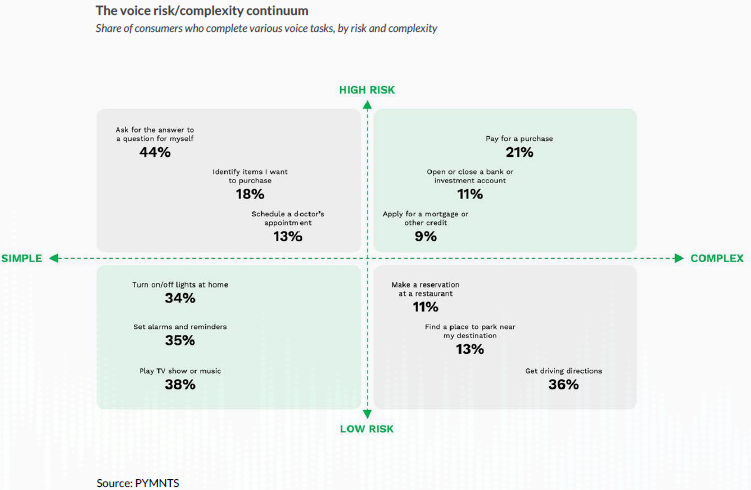Voice Tech Adoption Uneven as Consumers Aim to Balance Convenience With Trust

Consumers today are increasingly seeking smarter, simpler, and more connected routines, and voice technology has the potential to fulfill these needs. However, the adoption of voice technology remains uneven as consumers grapple with the balance between convenience and trust.
This is one of the key findings in “How Consumers Want to Live in the Voice Economy,” in which PYMNTS Intelligence draws on insights from a survey of nearly 3,000 U.S. consumers to examine their views and attitudes toward voice technology, especially how they use voice today, the friction they face and what they expect from voice technology in the future.

According to the study, while consumers are more comfortable using voice technology for simpler and low-risk tasks such as playing music, setting alarms, and asking for directions, concerns about data errors and security breaches that could compromise sensitive information hinder the use of voice technology for more complex tasks.
This includes tasks like opening a bank account or scheduling a doctor’s appointment involving the disclosure of personal and financial information, which only a small percentage of consumers, 11% and 13% respectively, are willing to use voice technology for.
Despite the current reservations, there is an expectation that as voice technology advances, consumers will gradually develop more trust in its ability to handle complex tasks with less risk.
In fact, there is a growing expectation among consumers that voice assistants will eventually be on par with human capabilities within the next five years — a belief is particularly prevalent among millennials and high-income consumers who tend to set technological trends.
Millennials, for example, complete nearly twice as many tasks compared to consumers across all segments who perform an average of six different tasks with this technology. Additionally, nearly half of this consumer segment are highly willing to pay more than $120 a year for a voice assistant as capable as a human, highlighting consumers’ willingness to pay for voice’s intelligence and functionality.
Against this backdrop, businesses that stay updated on the developments in voice technology and invest in it at the right time will be well-positioned to succeed in the future. In fact, it is anticipated that voice technology may become as common as the smartphone touchscreen in the near future. By recognizing and adapting to this trend, businesses can enhance customer experiences and stay ahead in the evolving digital landscape.
Overall, while the adoption of voice technology is uneven, consumers’ desire for smart, simple and connected routines is driving the demand for voice-enabled devices. As trust in the accuracy and security of voice technology improves, more consumers are expected to embrace its potential for completing complex tasks. Businesses that recognize and adapt to this trend will be able to leverage voice technology to enhance customer experiences and stay ahead in the evolving digital landscape.

